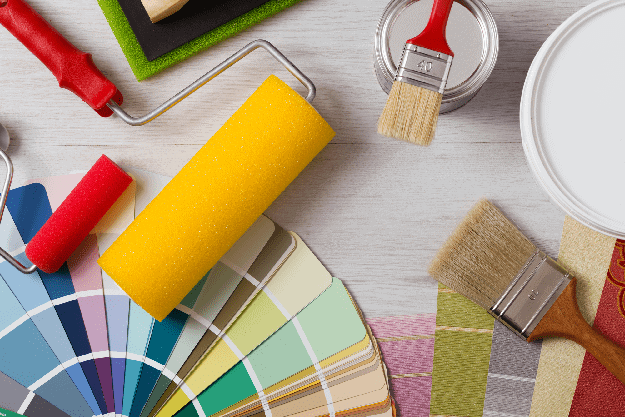With so many products available, it is easy to get confused when picking the right paint. Most people choose the paint color and finish first, before understanding the chemical components of paint. The advancements in the chemistry of paint allow for more specialty brands and products. Knowing the difference between interior and exterior paints will ensure a more successful paint job.

Types of Paint
All paint falls into two categories: water-based paints (also referred to as latex paint and acrylic paint) or oil-based paints. Until about ten years ago, oil-based paint was widely used on exterior surfaces because it was more durable and affordable. However, it has been proven that it is harmful, even deadly, to the environment and the people in the area where it is applied. Because of that the government has greatly restricted its use, except is very small amounts in rare situations.
Water-based paint is now the common choice for use in both interior and paint projects. There have been many improvements in the ingredients to improve adhesion and coverage and it has many additional advantages.
The drying time is significantly shorter than oil-based paint, which requires up to 48 hours to dry, leaving the room unusable during this time. Latex paints also have a minimal odor and release significantly fewer VOCs during the drying process.
Water-based painted surfaces are easier to clean and dry faster than those painted with oil-based paint. They resist yellowing and fading overtime if protected from sunlight. These paints are not flammable, and the odor is not noxious.
The Main Ingredients in All Paint
Both interior and exterior paints contain the same four basic components: Pigments, solvents, additives, and resins. Each ingredient plays a different role to produce a good product. Knowing what each component does will help determine what type of paint to use for any surface.
- Pigments are finely ground particles applied to paint that make up the paint’s color. There are two types of pigments: prime and extender. Colorants are prime pigments that provide the actual color in the paint can. Organic colorants provide bright colors. Inorganic colorants are earthy colors and are more durable for exterior applications.
- Solvents are the liquids that suspend the ingredients so that you can put the paint on surfaces. In water-based paints, the liquid is primarily water. For oil-based paints, the liquid is paint thinner made from a variety of solvents, which could include acetone, turpentine, naphtha, mineral spirits, and the like.
- Additives give paint different properties. These include thickening agents, leveling agents, surfactants, emulsifiers, and biocides. These help with color accuracy, improve application, better adhesion and prevent mildew growth.
- Resins bind the pigments together to create the paint film. Oil-based resins are made from oil derivatives such as linseed oil. Resins are the key ingredient that directly relates to paints performance characteristics.
What’s the Difference between Interior and Exterior Paints?
The main differences between interior and exterior paints are resins and additives. The binding resins for interior paints are rigid. They allow interior paint to be cleaned easily and are stain resistant. Vinyl acrylic resins are often used in interior paints to further enhance its scrub resistance and washability.
For exterior paints, the resins used are softer, providing for characteristics that help fight against fading, mildew, temperature changes and moisture. Exterior paint must also be tougher to resist peeling and chipping, To achieve these performance factors, 100% acrylic resins are used. They are regarded as the best overall. Their benefits include better adhesion and alkali resistance. Alkali resistance means the paint is less likely to “burn" over fresh concrete or masonry.
Paints also contain additives to regulate drying time, improve weather resistance, and keep the pigment distributed evenly in the paint solution. Interior paint’s lack of certain environment-specific additives gives it a disadvantage when used on exterior surfaces.
To withstand extreme weather conditions, exterior paints are designed to endure. The strength of some additives used in these paints may be unhealthy in enclosed indoor areas. Interior paint wouldn't last long if you used it to paint the outside of your house because it lacks heavy-duty additives.
Can’t Decide Which Paint to Use?
If you need help in deciding which paint to use for your next interior or exterior project, contact Walla Painting. We have many satisfied homeowners that use our services. Walla Painting is a locally owned business that specializes in residential home painting. We’ve won the Angie's List Super Service Award for the past eight years. Contact us for a free estimate for your next painting request.

Comments are closed.